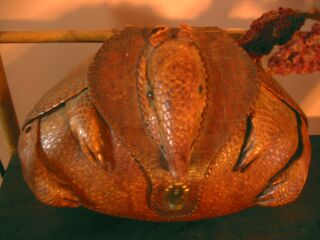January 08, 2004
transitional object - the launching of a meme

Photo note: This is an armadillo purse from my prop closet. I thought it an appropriate illustration for a transitional object, given that I am an armoured person. No teddy bears here. I hope it doesn't give you nightmares.
So here's the story how transitional objects came into consciousness. In 1941 during the Blitz, children were evacuated from London to the countryside for reason of safety. They were taken from their parents and placed in strange homes. Needless to say, this was traumatizing and they had lots of trouble. Donald Winnicott, a pediatrician, psychiatrist and meme launcher, was hired to consult in the hostels of Oxfordshire that housed the most disturbed children. Clare Britton , the woman who was to become his second wife, was the social worker for the hostels.
An excerpt from "The Untold Story of Donald and Clare Winnicott" :
"Throughout Clare's writings, themes and language commonly associated with Donald's work emerge repeatedly. In some instances, her references to certain ideas clearly preceded his discussion of similar concepts. A notable example of this is Clare's observations of transitional objects. During the War, Clare traveled to London to seek out the parents of the children in the hostels. When she found them, she asked them to prepare a note or "give me something to take to them" (Interview by Alan Cohen, June 27, 1980). In recollections of "Jane," an adolescent evacuee in her care, Clare specifically notes the significance of a gift of grapes from Jane's abusive mother. Also, after Jane stole a valued ring of a hostel parent, Clare asked her to lend Jane her ring on Sundays--to tell Jane "it's very precious to me but you could have it one day a week" (Interview by Alan Cohen, June 27, 1980).
In 1947, Clare's unpublished case notes of her work placing a foster child in an adoptive home illustrate how Clare supported the child's use of a toy duck in the transition to a new home. Several years later, in 1950, Clare describes this phenomenon in evocative detail:
The moment of uprooting is just when a skilled child-care officer is needed to see that what a child clings to in the past is brought with him and accepted in the new environment. ....there are many stories, which now, it is hoped, belong to another era, of children clinging to their own clothes and being given an anesthetic to enable the clothes to be removed, or favourite but filthy teddy-bears and other possessions being taken away and burned, but these did not belong to the past, and something became damaged and lost when the familiar things were taken away. These possessions stood for everything the child brought with him from the past and he could not afford to lose so much. (C. Britton, 1950)."
I have occasion to sit with a woman, T, who lost her transitional object. She grew up in a household with a narcissistic, Italian mother, of the beauty queen variety. The sexual energy between her parents palpably saturated the energy field in the family. T. shared a room with her younger sister, who hated her and often destroyed her possessions. She was passionately attached to a stuffed dog with whom she soothed herself to sleep every night. (Her parents, with foresight, had given her sister an identical dog, so that Fluffy was fairly safe from destruction.)
When T. learned to masturbate, at about age 9, she involved Fluffy in the process. One day Fluffy, her beloved, was gone. T. was despondent, certain that her sister had taken him. He could not be located, so she learned to do without him, believing that he disappeared because she was using him for wicked purposes.
Two years later she found Fluffy in the back of the linen closet. She then surmised that her mother knew she was masturbating, and had removed Fluffy to put a end to the practice. She was flooded with shame, and felt helpless to reclaim her beloved.
How this traumatic template has influenced T's life.
Whenever she feels a passionate attachment to another person, she believes the relationship will vanish into thin air. She suffers terribly from this projection, and is in an almost constant state of feeling abandoned. She dumped her first love because, acting on her transitional object template, she was convinced that he had abandoned her, because he decided to play a professional sport instead of attending college which entailed a geographic move. In spite of the fact that he pursued her mightily for almost three years, she could not allow herself to believe that he was, in fact, still around.
She avoided passionate attachments after that, and chose to marry a nice man, toward whom she felt affection. She knew that he loved her more than she loved him and therefore would not leave her. She is dissatisfied in her marriage.
She is passionately attached to her children. She just couln't avoid it. She weeps when she imagines her children leaving home. Each grade change for each child is a step closer to the day they will vanish.
.
Of course, the story is more complex, but that's a good deal of damage from the disappearance of one little stuffed dog.